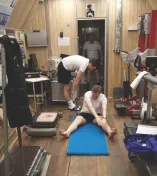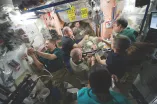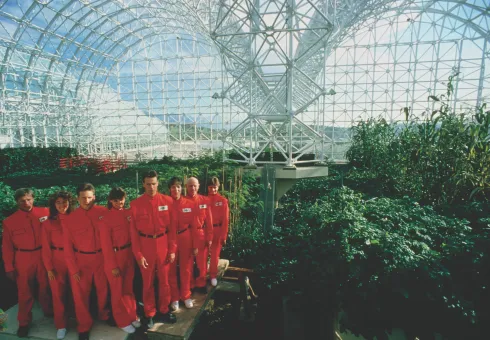By Sean Blair

Image credit: BBC
Like many a space opera before it, Outcasts plays fast and loose with scientific fact, but life beyond Earth is already a reality. On 2 November last year, the International Space Station (ISS) notched up a decade of continuous occupation.
The experience has taught scientists much about how the human body and brain cope with living in space, but now a project is underway examining the physical and psychological effects of the long trip needed for man to reach Mars.
In June 2010, six volunteers were shut away in a hermetically sealed set of modules at Moscow’s Institute Of Biomedical Problems. They will reside within their 550m2 habitat for 520 days – the time needed to go to Mars and back – while performing scientific and maintenance tasks. This Mars500 crew (seen exercising in the image below) is being observed continuously to gain insights into the physiological and psychological effects of prolonged isolation.

The results should help guide planning for future space expeditions. The fact that humans can live off-world has been firmly established in the last 50 years since Yuri Gagarin’s first orbit. However, being able to thrive there, rather than simply survive, is the agenda for the next half-century.
There is no lack of places to go. The lunar poles score high in terms of water availability. A colony at the lunar poles would also minimise the extreme temperature shifts of lower latitudes. Mars is a thousand times further from us than the Moon, but offers much more in the way of usable chemical resources.
Its atmosphere is only a hundredth as thick as Earth’s, but offers some protection against meteoroids and radiation and reduces the temperature range between day and night.
A base on Mars also means easy access to Phobos and Deimos – asteroids that have been captured by the planet’s gravity. These moons could be useful preparation for follow-on colonies: ‘carbonaceous chondrite’ asteroids offer the best prospect of harbouring hydrates and other volatile substances, allowing settlers to live off the land.
Once asteroid living is mastered, humanity could live pretty much anywhere, all the way out to the icy realms of the Kuiper Belt and the Oort Cloud.
Dramatic licence
Reaching another solar system within four decades, as the colonists in Outcasts do, stretches dramatic licence. NASA’s New Horizons probe, for example, is midway through a nine-year journey to the Solar System’s edge, an insignificant distance in interstellar terms.
For a truer insight into the colossal distance of a trip to even the nearest star, imagine a 26-mile marathon: its runners would depart our Solar System with their very first step.
Then imagine the difficulty of sustaining a human crew for the whole of that journey. Current manned spaceflight presents enough of a challenge – an astronaut breathes at least 250ml of oxygen per minute and ingests 2,000 calories and 2.5l of water daily, all the while being kept at standard atmospheric pressure within a comfortable temperature range of about 17° to 27°C and 30 to 70 per cent humidity.
They exhale 1kg of poisonous carbon dioxide daily, along with smaller amounts of hazardous chemicals such as methane, ammonia and acetone. All this must be disposed of, as must a daily 200g of faecal matter and even human body heat.
Adapting to space
A few millimetres of aluminium hull is enough to keep the hard vacuum of space at bay, preferably topped with multi-layer shielding to protect against micrometeorites. There is no way to block out weightlessness, however – its myriad challenges begin with so-called ‘space adaptation syndrome’, suffered by about half of astronauts during their first few days in orbit.
“It takes time for your sense of balance to get used to weightlessness,” says Frank De Winne, first European ISS commander. “It’s unfortunate timing because the first few days are when you require 150 per cent effort, with docking and loading and so on.”
Sickness is an accepted part of initial on-orbit operations. NASA even has its own 10-point measuring system for relative nausea, dubbed the ‘Garn Scale’ after famously afflicted 1985 Shuttle passenger Senator Jake Garn.

Astronauts’ faces change too. “The fluid that gravity normally keeps pooled down in your legs floats up to your head,” explained De Winne. “I also had a sore back, because it takes a quite different set of muscles to move around while weightless. The surprising thing though, is how quickly the body adapts to all this.”
A few days in, increased urination has brought down astronauts’ puffy faces and they master microgravity motion, adopting a characteristic foetal hunch.
But sustained space living brings other problems. Use it or lose it is the law of human physiology. Freed from the need to resist gravity, bone, muscles and heartbeats soon weaken. Even with vigorous exercise, up to 1 per cent of bone mass may be lost each month.
Legs become under used – their circumference can decrease by a third. And calcium leaking from shrinking bones increases the threat of potentially debilitating kidney stones.
Astronauts also complain about losing their sense of taste – the reason is uncertain – and minor wounds take longer to heal due to under-performing immune systems. The culprit is believed to be increased radiation exposure.
Early space travellers had their vital signs measured routinely with biosensors – today this occurs only during spacewalks. Modern astronauts are never without radiation dosimeters to measure their cumulative exposure and undergo a strict regimen of medicals before, during and after flight.
Life on Mars
With data gathered for Earth orbit, how different might planetary living turn out to be? British Antarctic Survey scientist Charles Cockell led a study on Martian expeditions for the British Interplanetary Society.
The medical consensus was that the 0.38 per cent of Earth gravity on Mars could well be too low for significant health benefits, while increasing the overall risk of astronaut injury.
Peroxide-rich Martian dust also presents a hazard – it is chemically reactive and small enough to lodge within the lungs. Radiation exposure would be heightened – though settlers could at least shield themselves underground.
There are additional local quirks. Martian spacewalkers will need spacesuits with cooled boots and heated helmets, and the scant atmosphere induces a steep temperature gradient, making ground level 20°C warmer than head level.

Psychologically stable
But whether settling planetary bodies or space itself, the fundamental long-term challenge will be psychological rather than physical in nature. “Living in space involves lots of small constraints, which add up to cause psychological stress,” says De Winne. “It’s like being forced to stay in your house all the time. There are times when you’d like to step outside but that is not an option.”
Russian cosmonauts, two decades ahead of everyone else in long-duration missions, call the resulting syndrome ‘asthenia’, with symptoms such as excessive tiredness, unstable moods and disturbed sleep.
Astronauts are, of course, specially selected for psychological stability. But there are ways of reducing susceptibility to stress – private quarters, however small, mean the crew can get away from each other, while frequent communication with loved ones reduces feelings of isolation.
Staying busy sharpens crew morale, and environmental factors also contribute – the Russians paint their ISS modules in earthy, relaxing colours (see image of mealtime on the ISS, above) while US modules come in sterile, airliner grey. “Passing from the Russian to US side feels like going from home to work,” observes UK-born astronaut Michael Foale.
Assessing such slippery human factors is where Mars500 comes in. “There are a lot of questions that can more easily and appropriately be addressed through ground-based studies,” says Jennifer Ngo-Anh, head of the isolation experiment for ESA. The answers could contribute to a drama like Outcasts becoming reality for future generations.
Case study: Biosphere 2

Funded by philanthropist Edward Bass, Biosphere 2 is the second largest closed-loop ecosystem after Earth itself, with five ‘biomes’ including a tropical rainforest and coral reef. Today it is employed for environmental science experiments but was originally designed to prove the idea of self-supporting biospheres for space colonisation.
Amid media fanfare, an eight-strong team of ‘Biospherians’ (pictured above) were sealed inside Biosphere 2 on 26 September 1991. They planned to stay there for two years and 20 minutes.
Things did not go to plan. Many of the 3,800 species within the glass died off, while the ant population exploded, carbon dioxide levels fluctuated wildly and oxygen levels dropped dangerously low – the missing oxygen later turned out to have been absorbed by the Biosphere’s concrete structure.
The crew would be regularly woken from sleep because they were gasping for air. Their weight plunged as poor weather affected crops that proved dependant on the Sun. They had to eat so many sweet potatoes that their skin turned orange.
The Biospherians became a classic case study in isolated group behaviour – splitting into two mutually loathing factions. “We went nuts,” said UK participant Jane Poynter.
The main point of disagreement: should extra oxygen be pumped in to give the crew sufficient energy to continue scientific research, or should Biosphere 2’s integrity be respected at all costs? The final decision to allow in extra air came after Poynter lost a finger in a threshing accident and was let out to have it re-attached.
A second two-year human stay ended early in 1994, not helped by embittered first crew members reportedly vandalising Biosphere 2 from the outside. It is now a research centre for Arizona University.
This article appeared in issue 65 of Sky at Night Magazine, October 2010
